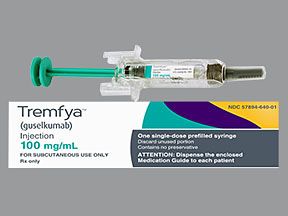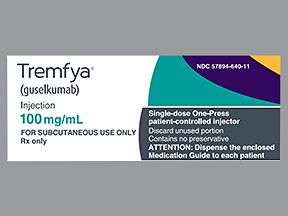Tremfya (guselkumab) is a brand-name drug prescribed for plaque psoriasis and other inflammatory conditions in adults. Tremfya comes as an injection. The dosage can vary depending on the condition the drug is used to help treat.
The Food and Drug Administration (FDA) has approved Tremfya to treat the following conditions in adults:
- moderate to severe plaque psoriasis
- active psoriatic arthritis
- moderate to severely active ulcerative colitis (UC)
“Active” means that the condition is currently causing symptoms.
Tremfya is usually given as a subcutaneous injection. However, it’s administered as an intravenous (IV) infusion at the beginning of treatment for UC.
The active ingredient in the drug is guselkumab, which belongs to a class of medications known as interleukin-23 (IL-23) blockers. Tremfya is a biologic drug. It’s not available as a biosimilar.
Keep reading for information on the dosages of Tremfya, as well as details on its forms, strengths, and how to take the drug.
Note: For a comprehensive look at Tremfya, see this article.
Here you’ll find information on typical dosages for the conditions Tremfya treats.
Tremfya forms
Tremfya comes in the following forms, which all contain a single dose of the drug in a liquid solution:
- prefilled syringe
- prefilled One-Press injector
- prefilled pen
- vial
The syringe, One-Press injector, and pen are used to provide a subcutaneous injection. This is an injection under the skin. The One-Press injector contains a hidden needle, so it may be a good option if you aren’t comfortable with needles. The injector may also be easier to use than a syringe. Your doctor can discuss with you the differences between the forms and which one may be right for you.
The vial contains solution used to provide an IV infusion. An IV infusion is an injection into a vein that’s given over time. If you’re receiving Tremfya for UC, you’ll have IV infusions at the start of treatment. Then your doctor will switch you to subcutaneous injections.
Tremfya strengths
The forms of Tremfya for subcutaneous injection contain a single dose of the drug in the following strengths. The strengths are given in milligrams per milliliter (mg/mL).
| Tremfya form | Strength(s) |
|---|---|
| prefilled syringe | 100 mg/mL and 200 mg/2 mL |
| prefilled pen | 200 mg/2 mL |
| One-Press injectors | 100 mg/mL |
For IV infusion, the single-dose vial comes in one strength: 200 mg/20 mL.
Typical dosages
The following information describes the standard Tremfya dosages.
Dosage for plaque psoriasis and psoriatic arthritis
The dosage of Tremfya for moderate to severe plaque psoriasis and active psoriatic arthritis is the same.
You’ll first receive two starter doses. The first dose will be a 100-mg injection. After 4 weeks, you’ll receive another 100-mg injection.
The starter doses are similar to loading doses. They’re meant to quickly raise the level of Tremfya in your body so that the drug can start working.
After the first two doses, your dosing schedule will be one injection of Tremfya every 8 weeks. These are known as maintenance doses.
Note: For psoriatic arthritis, you may take Tremfya with other medications called disease-modifying antirheumatic drugs (DMARDs).
Dosage for ulcerative colitis
For treating UC, you’ll receive your starting doses as IV infusions. This part of treatment is known as induction. It’s called this because it’s meant to induce remission. With remission, you have no symptoms or few symptoms of UC.
For induction, a healthcare professional will give you a 200-mg dose by IV infusion over the course of at least 1 hour. You’ll receive a total of three infusions with 4 weeks between each infusion.
After induction, you’ll switch over to maintenance treatment. The purpose of this part of treatment is to keep UC in remission. For maintenance, you’ll receive subcutaneous injections of Tremfya. Your doctor will recommend one of the following dosages:
- a 100-mg dose 8 weeks after your last infusion, followed by a 100-mg dose every 8 weeks
- a 200-mg dose 4 weeks after your last infusion, followed by a 200-mg dose every 4 weeks
Long-term use
Tremfya is meant to be used as a long-term treatment. If you and your doctor determine that Tremfya is safe and effective for you, you’ll likely take it long term.
Here you’ll find information on how Tremfya is given.
Tremfya by subcutaneous injection
For your first dose of Tremfya, your doctor will show you or your caregiver how to inject Tremfya subcutaneously. After that, you or your caregiver will be able to inject the medication. When you do, be sure to follow your doctor’s instructions carefully.
You can also find step-by-step instructions on how to administer Tremfya using a syringe, pen, or a One-Press injector under “Instructions for use” in the Tremfya prescribing information. In addition, the manufacturer’s website has how-to videos for injecting Tremfya that you may find useful.
The manufacturer recommends injecting Tremfya into the skin on the front of your thigh. But you can also inject into your lower abdomen (except within 2 inches of your belly button). Or, the drug can be injected into the back of your upper arm, but only if a caregiver is giving the injection.
Before injecting
Before giving yourself a dose of Tremfya:
- Take the medication out of the refrigerator and let it sit at room temperature (68°F to 77°F/20°C to 25°C) for at least 30 minutes.
- Always check the solution. It should be clear or slightly yellow, and it may have small particles in it. If it’s cloudy, discolored, or contains large particles, discard the dose and use a new one.
- Only use an injection device once. The prefilled syringe, pen, and One-Press injector are single-use only. This means that they hold one dose and should be discarded after one use. Do not reuse a syringe, pen, or injector.
Tremfya by IV infusion
For the first three doses of Tremfya for UC, a healthcare professional will prepare and give you the drug by IV infusion in a clinic, infusion center, or other medical setting. Your doctor will let you know what to expect with the infusions.
The infusions take at least 1 hour. However, you’ll want to allow more time for your infusion appointment, including travel time to the location. Your doctor can let you know how much time the appointment will take.
If you forget to take a dose of Tremfya, take it as soon as you remember. Take your next dose at the regularly scheduled time. Don’t reset your dosing schedule to make up for the missed dose. If you aren’t sure what to do or have a question, call your doctor.
If you miss an appointment for an IV infusion, call your doctor’s office to reschedule right away.
To help make sure you don’t miss a dose, try using a medication reminder. This can include setting an alarm or timer on your phone or downloading a reminder app. A kitchen timer can also work.
If you take more Tremfya than your doctor prescribed, call them right away. You can also call America’s Poison Centers at 800-222-1222 or use its online tool.
But if you have severe symptoms, immediately call 911 or your local emergency number or go to the nearest emergency room.
As with any drug, you shouldn’t change your dosage of Tremfya without your doctor’s approval. If you have questions about the dosage of Tremfya that’s right for you, talk with your doctor.
In addition to dosage, you may want to explore other information about Tremfya. If so, these articles might be helpful to you:
- More about Tremfya: For information about other aspects of Tremfya, refer to this comprehensive article.
- Details on psoriasis, psoriatic arthritis, and ulcerative colitis: For details on these conditions, see our psoriasis hub, our list of psoriatic arthritis articles, and our list of ulcerative colitis articles.
Disclaimer: Medical News Today has made every effort to make certain that all information is factually correct, comprehensive, and up to date. However, this article should not be used as a substitute for the knowledge and expertise of a licensed healthcare professional. You should always consult your doctor or another healthcare professional before taking any medication. The drug information contained herein is subject to change and is not intended to cover all possible uses, directions, precautions, warnings, drug interactions, allergic reactions, or adverse effects. The absence of warnings or other information for a given drug does not indicate that the drug or drug combination is safe, effective, or appropriate for all patients or all specific uses.



